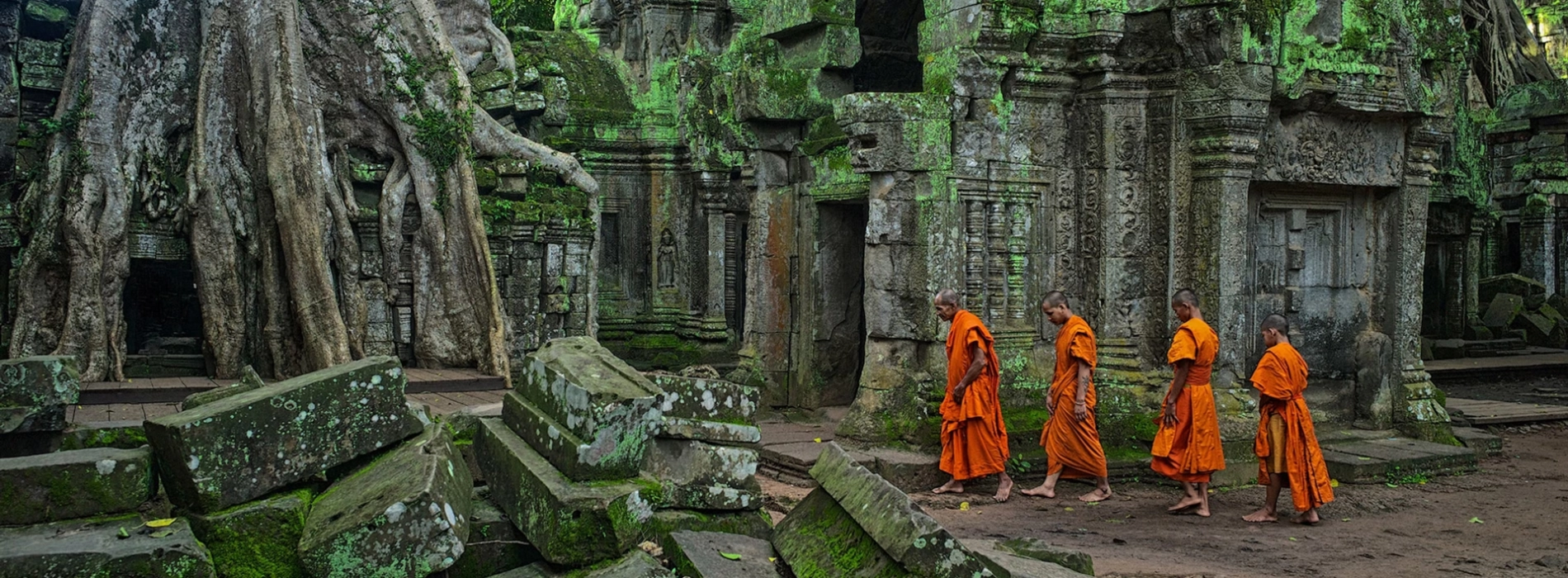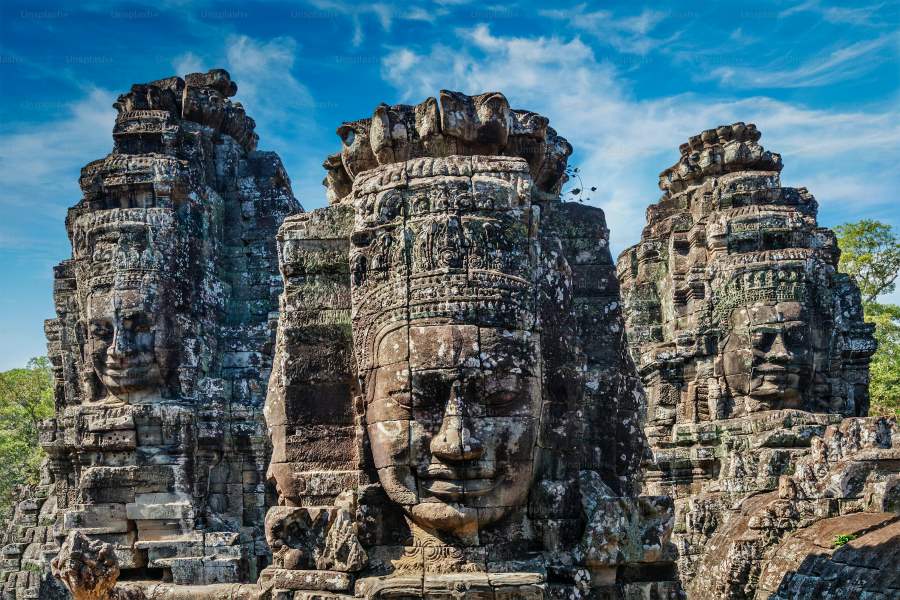Siem Reap

Siem Reap is a city located in the northwest of Cambodia, on the shores of Tonle Sap Lake. Being the entrance to the Angkor complex, it is a popular tourist attraction. Because of this, Siem Reap is a destination where tourists can take part in fascinating activities in a rich cultural heritage area.

Siem Reap is a city located in the northwest of Cambodia (Cre: roma.lim)
According to Cambodians, Siem Reap means "defeated Siam," referring to the Khmer Empire's victory over the Thai forces in the 17th century. Angkor Wat, a few kilometers from Siem Reap, was built by King Suryavarman II in the early 12th century. Angkor Thom, not far from Angkor Wat, was built by King Jayavarman VII and was the Khmer Empire's capital.
The capital was moved to Phnom Penh in 1432, then to Lovek and Udong, and finally back to Phnom Penh in 1866. Conflicts caused the ancient temples of Siem Reap to collapse and be forgotten. They were rediscovered in the 19th century by Western missionaries and adventurers.
Many visitors today fall in love with Siem Reap on their first trip there. With its many East Asian architectural wonders, stunning eco-tourism locations, and nice, temperate weather, the city is perfect for exploring and taking in the sights.

Many visitors today fall in love with Siem Reap on their first trip there (Cre: Unsplash)
You may like: Cambodia Excursions
Because of its close proximity to the Angkor temples, Siem Reap, which is located in northwest Cambodia, is the primary tourist attraction in the nation.
Because of its close proximity to some of the most well-known attractions in the world, this city boasts an easy-to-use transport system. Once you land at Siem Reap International Airport, you can travel throughout the city on buses, motorbikes, taxis, and tuk-tuks. Due to the large number of vehicles gathered in Siem Reap to accommodate visitors to famous attractions, transportation is easily accessible.

Siem Reap boasts an easy-to-use transport system (Cre: Indochina Voyages)
To visit Siem Reap under the best conditions, you should travel to Cambodia from November to April. During this period, the weather is cool and pleasant, making it ideal for exploring ancient historical sites and discovering the city.
Traveling during the rainy season might occasionally disrupt your journey, but you will also have unique and interesting experiences during this time.

The best time to visit Siem Reap (Cre: recits.daventures)
Angkor Wat complex
Angkor Wat is a temple complex in Cambodia and is the largest religious monument in the world. It is located 5.5 kilometers north of Siem Reap.
Angkor Wat combines two key features of Khmer architecture. The center of the temple has a group of five towers: one central tower and four towers at the corners of a square.
The Angkor Wat temple complex is admired for its majestic and harmonious architecture, rich sculpture art, and numerous gods depicted on the stone walls.

Angkor Wat is the largest religious monument in the world (Cre: Nam Viet Travel)
Pub Street and Night Markets
Pub Street is a lively and vibrant destination, featuring a bustling shopping district that sparks curiosity and excitement in visitors. This area is renowned for its dining, shopping, and entertainment options in Siem Reap and is typically open in the evenings.
Additionally, the Angkor Night Market operates from around 4 p.m. until after midnight. The market primarily offers souvenirs, food, jewelry, and other items popular with tourists.

Pub Street is a lively and vibrant destination (Cre: marctivist)
Phnom Kulen National Park
About two hours by car from Siem Reap is Phnom Kulen National Park, a great place to visit with beautiful waterfalls on Kulen Mountain. This is where King Jayavarman II declared independence and started the ancient Khmer Empire in the 9th century.
At Phnom Kulen National Park, visitors can explore old tropical forests, enjoy cool waterfalls, and see historical temple ruins that have survived for centuries. Many of the religious buildings here are still well-preserved, making it a popular spot for those interested in culture and history.

Phnom Kulen National Park in Siem Reap (Cre: Expedia)
Floating Villages on Tonle Sap Lake
Tonle Sap, or Cambodian Lakes, is a combined system of lakes and rivers of great importance to Cambodia. The hydrological system changes flow twice a year, creating a rich and diverse ecosystem.
The floating villages on Tonle Sap Lake, where residents live entirely in beautiful houses close together, with schools, churches, and temples, are a unique feature that attracts many tourists.

Floating Villages on Tonle Sap Lake (Cre: Asian Trails)
Like other tourist centers, the food in Siem Reap is very diverse due to the cultural mix from various countries. You will also find many international dishes from places like India, Europe, Vietnam, China, Japan, and more. If you want to eat like a local, visit street food stalls in the night market or on streets away from the city center.
Traditional Cambodian dishes include Khmer Curry, Fish Bread Crumb (deep-fried river fish), Amok (a type of fish curry), and Lab (a flavorful dish).

The food in Siem Reap is very diverse due to the cultural mix from various countries (Cre: Delicious)

Some tips when traveling to Siem Reap (Cre: KAYAK)
A popular tourist destination in Cambodia, Siem Reap is renowned for its many attractions, exceptional tourist services, and delicious cuisine. The city is renowned for its stunning ancient temples, including the Angkor complex, the world’s largest religious monument. Visitors to Siem Reap can expect an exciting and memorable experience!
You may like: Cambodia tours 5 days
Discover in depth the secrets of Angkor Wat region during our Siem Reap Tour 4 D...
Enjoy the Phnom Penh Siem Reap Tour 5 days: Cambodian Heritage to countryside to...
Embark on Angkor Trekking Tour 3 Days: Jungle Trek & Temple Discovery through th...
Experience the ultimate adventure with our Siem Reap Trekking Tour 3 Days: Phnom...
Embark on Siem Reap Trekking Tour 3 Days: Explore Siem Reap with Asia King Trave...